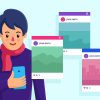Your house’s roof is its ultimate defense against harsh weather, pesky creatures, and infestations.
If your roof is not in top condition, your entire house is at risk. It’s crucial to schedule roof repair as soon as you notice a leak, even if it’s small, as it can cause significant damage.
Repairing your roof is more cost-effective than replacing it entirely and is vital to maintain its integrity.
Left unaddressed, roof leaks can cost you tens of thousands of dollars.
This article will discuss the basics of roof repair, what you need, and how to do it. Ensuring your roof is in top condition is essential to protect your home from the elements and ensure its longevity.
Steps For Repairing Your Roof
Given below are the steps that will guide you in the process of roof repairing at your home—
1. Examine The Damage
Following a systematic approach is vital when searching for a leak in your roof. Begin by surveying the visible damage to your roof, including shingles, gutters, and roof edges.
It’s essential to start with the most obvious issues and progress to less apparent ones. Once you’ve assessed the exterior, examine the interior for signs of water damage.
Look for indications of water stains, dripping water, sagging, pooled water, and dampness. Inspect during rainy weather, as some leaks are intermittent and only occur when there is enough rain.
Access the attic using a flashlight to locate the water source through the roof deck. Check around all rafters for indications of water.
Water can travel through the roof decking and rafters due to the force of gravity, which may result in dripping in different areas. If you observe water dripping, trace it back to its origin.
2. Find A Reliable Contractor
After a thorough inspection of your roofing system by a professional roofing consultant, you will receive an accurate and detailed bid or estimate.
The estimate will be based on the materials you choose for your roofing projects. Moreover, you must consider the unique measurements of your roof.
The roofing consultant will also consider any special conditions that may affect the cost. This can include the complexity of the roof design or any existing damage that needs repairing.
Once you receive the bid or estimate, your roofing contractor should provide a written contract outlining the details.
This contract should include a comprehensive breakdown of the costs, the expected timeline for completion, and any warranties or guarantees included.
Therefore, you must carefully review and understand the contract before agreeing to any work to ensure everything is clear and fair for both parties.
3. Select The Suitable Material
It’s crucial to have a complete set of roofing tools when undertaking any repair project. These hand tools have various uses throughout the house.
They include the following:
- Roofing hammer.
- Pry bar.
- Nail puller.
- Utility knife.
- Shears.
- Tin snips.
- Handbrake.
- Tape measure.
- Chalk box.
- Roofing nails (also known as roofers).
- Speed squares.
- A pencil for notes or markings.
- A 10 oz clay gun.
Choosing the right roofing sealant depends on the roofer’s needs, but any kind will suffice.
While shingles are optional, matching them is optional. For flashing work, it’s recommended to use aluminum coil stock, which is available in various colors at most box stores.
A tape measure is recommended for all measurements and layout work, and a chalk box is ideal for snapping reference lines and general layout work.
Roofing nails, or “roofers,” are recommended for their durability. The materials used for the roofing sealant, shingles, and aluminum coil stock are also essential.
4. Ensure That All Cracks Are Sealed
Using an uncomplicated roofing sealant is important to seal any cracks on your roof.
To apply a sealant, you must pierce a thin aluminum membrane with the tube, allowing the sealant to flow.
Next, load the sealant into a caulk gun and aim it at the crack or hole to seal it.
The sealant will dry in a few hours and be set entirely in 24 hours without intervention.
Finally, you can cover the hole with shingles or flashing and move on to other projects. Ensuring that the roof sealant is compatible with your caulk gun is crucial. This is because some construction materials come in 28-ounce tubes that won’t fit a standard 10-ounce gun.
5. Ensure The roof Is Insulated
When planning to replace your roof, it’s also a good opportunity to consider upgrading your insulation.
However, if you opt for new blown-in insulation, your roofing contractor will install it while they remove the decking.
This insulation process requires running a hose through the exposed roof and into your attic. It allows the insulation to be installed quickly and easily without causing any damage to your walls or ceilings.
Therefore, with the new insulation, you can enjoy improved energy efficiency and a more comfortable indoor environment.
6. Leave It Clean
After the roofing crew installs your new roof, they should clean up any debris around your home. This includes loose shingles and nails and leaves them in their original condition.
They should also haul away old roofing materials for proper disposal. Additionally, you must ensure not to dispose of in landfills, which can contribute to pollution.
The roofing expert must inspect the final product to ensure it meets all industry standards and building codes.
They should also check for potential leaks or damage and address any concerns.
It is important to address any concerns and take steps to correct any issues. Therefore, ensure you’re completely satisfied with the new roof and its reliable protection for years.
Can You Repair Your Roof Yourself?
Understandably, as a homeowner, you may want to save money. Therefore, taking care of some home maintenance tasks can help you save a lot.
However, it is important to know your limits when it comes to your roof.
You may be capable of handling minor tasks such as replacing caulking or cleaning gutters. On the other hand, leaving any roofing projects to the professionals is highly recommended.
Moreover, roofing maintenance requires specific skills, knowledge, and equipment that only experienced and trained professionals possess.
Even a seeming DIY project can quickly spiral into a much bigger roof repair if something goes wrong.
Therefore, it’s always wise to prioritize the safety of your home and family. Look for an efficient roofing service provider and explain the damage.
You can get your roof cost-effectively repaired under expert supervision!
Read Also:























All Comments
Temp Mail
I appreciate you sharing this blog post. Thanks Again. Cool.